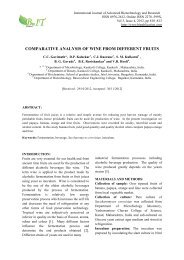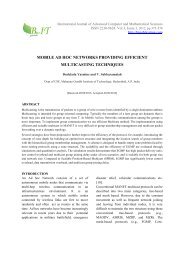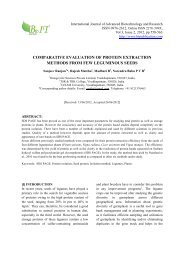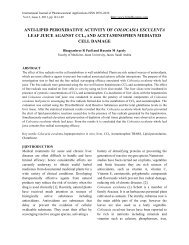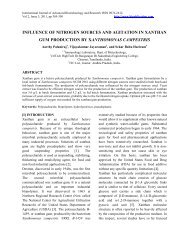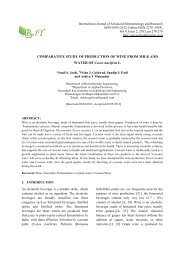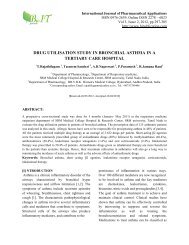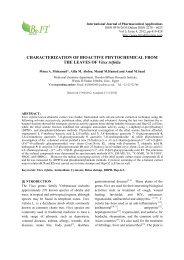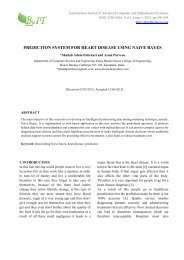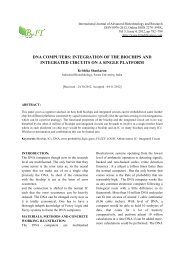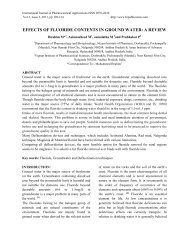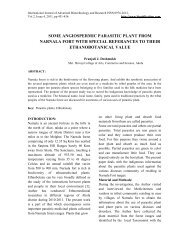1-5 - BioIT international Journals
1-5 - BioIT international Journals
1-5 - BioIT international Journals
Create successful ePaper yourself
Turn your PDF publications into a flip-book with our unique Google optimized e-Paper software.
International Journal of Advanced System and Social Engineering Research<br />
ISSN 2278 - 6031,<br />
Vol 3, Issue 1, 2013, pp1-5<br />
http://www.bipublication.com<br />
UNDERSTANDING CUSTOMER RESPONSE AND CUSTOMER SATISFACTION<br />
OF MOBILE BANKING IN INDIA<br />
1 Sandeep Bhalchandra Saoji and 2 Pradip Kumar Goel<br />
1 Buldhana Business Management College, Buldhana, India<br />
2 Jatan Swaroop Postgraduate College, Sikandrabad, India<br />
[Received-25/12/2012, Published-09/01/2013]<br />
ABSTRACT<br />
There have been a number of innovations done in banking industry in recent years. Mobile banking is one of them. Almost all<br />
the banks in India provide mobile banking facilities to their customers and the mobile banking facilities offered by the banks are<br />
based on different types of platforms. There is a strong relationship between service qualities, perceived value with the customer<br />
satisfaction in mobile banking. There are several factors that determine the customer satisfaction of mobile banking in India and<br />
they are efficiency, security, cost effectiveness, fulfillment, problem handling and accuracy in results. This paper aims to analyze<br />
the customer response and customer satisfaction of mobile banking through these factors.<br />
INDEX TERMS— Mobile Banking, Customer Satisfaction, Mobile Banking India, Customer response<br />
I. INTRODUCTION<br />
The mobile banking is considered as the provision of<br />
banking services to the customers on their mobile<br />
phones and other mobile devices. Mostly, mobile<br />
banking is used for operation of the bank in case of<br />
current and deposit or savings account. According to<br />
studies and researches done, mobile phones and other<br />
handheld devices have been established firmly as an<br />
alternative form of payment in the technological<br />
advanced societies. Apart from the banks, the mobile<br />
service providers and operators are also putting efforts<br />
to promote and offer mobile payment services. The<br />
adoption of the mobile banking services has resulted in<br />
the innovation of new services in mobile banking [1].<br />
Many researchers stated that the customer adoption is<br />
the main reason for the success of mobile banking<br />
across the world. Mobile payments are immensely used<br />
in many advanced countries. Mobile payments are<br />
defined as the use of mobile phone or device to make a<br />
payment from a payer to the receiver through an<br />
intermediary or without any intermediary [2]. Most of<br />
the mobile banking services are based on application.<br />
The customers are provided with the website location<br />
from where they can download the application to use<br />
mobile banking service and the application is different<br />
for different banks. There are some banks that provide<br />
SMS based mobile banking services. In order to use<br />
the application based mobile banking solution, the<br />
customers need GPRS enabled mobile phone and an<br />
active internet connection. There are various types of<br />
activities that can be done through the mobile banking
UNDERSTANDING CUSTOMER RESPONSE AND CUSTOMER SATISFACTION<br />
[3]. The first activity that can be done through mobile<br />
banking is checking account balance. In order to check<br />
the balance in account, the customers were needed to<br />
visit the brand few years before. After that, ATM<br />
facility came into the market but one needs to visit the<br />
ATM counter to check the account balance. In mobile<br />
banking facility, one can check account balance<br />
anytime they want. They do not need to go anywhere.<br />
They just need to open the application for mobile<br />
banking and they can check their balance by entering<br />
their PIN which is provided by the banks while<br />
opening the account [4]. Now, the 3G services has<br />
made the internet technology quite improved a huge<br />
number of people are using 3G in their mobile phones<br />
or any other handheld devices.<br />
In India, the banking industry is bit different from<br />
other countries. The banks in India have not faced any<br />
huge downfalls or losses and all of them are well<br />
capitalized. There are mainly three types of banks in<br />
India. The first category is Nationalized Banks. There<br />
are a total of 27 nationalized banks in India and the<br />
most popular of them are State Bank of India, Central<br />
Bank of India, Indian Overseas Bank, Canara Bank,<br />
Bank of Maharashtra, United Bank of India, Punjab<br />
National Bank, Union Bank of India and others.<br />
Second category is Private Sector Banks [5]. There are<br />
many private sector banks in India such as Axis Bank,<br />
ICICI Bank, HDFC Bank, Indusind Bank, ING Vysya<br />
Bank, City Union Bank, Yes Bank, Kotak Mahindra<br />
Bank etc. There are many foreign banks too that are<br />
operating their business in India such as HSBC, ABN<br />
Amro, BNP Paribas, Citibank, DBS Bank, Royal Bank<br />
of Scotland, JP Morgan, State Bank of Mauritius.<br />
Almost all of these banks provide mobile banking to<br />
their customers which help them to operate their<br />
account easily.<br />
II. AIM OF THE PAPER<br />
The main aim of the paper is to analyze the customer<br />
response and customer satisfaction of mobile banking<br />
in India.<br />
III. EFFICIENCY OF MOBILE BANKING<br />
Most of the customers using mobile banking found it<br />
quite efficient. They are able to access to a huge<br />
number of mobile banking services. They can check<br />
their account information such as mini statement and<br />
account transaction history. Term deposit is one of the<br />
major financial activities done by the Indian people<br />
today and it is quite difficult to keep track of their<br />
deposits [6]. Customers had to visit the branches of<br />
banks every month to check the status of their term<br />
deposits. With the help of mobile banking, people can<br />
check the status of their fixed deposits. Credit Card is a<br />
common thing which every Indian has. People can<br />
access to the credit card statements and loan statements<br />
through mobile banking. Other account information<br />
such as insurance policy management, status of check<br />
and stop check payment etc can be done through the<br />
mobile banking [7]. People can also order for new<br />
checkbooks through the mobile banking. There are<br />
some banks in India which offers facilities like<br />
blocking of cards if lost or stolen in mobile banking.<br />
The processes of using mobile banking are very easy<br />
and everybody can use it. Most of the people like to<br />
use application based mobile banking than the SMS<br />
based mobile banking due to various reasons [8].<br />
People do not need any extra skill to use the<br />
applications. People just need to install the application<br />
in their mobile and they need to enter the PIN to get<br />
started with the application. Some extra facilities are<br />
offered by the Indian banks in mobile banking [9]. The<br />
users of mobile banking can recharge their mobiles<br />
through this. They can also pay electricity bills and<br />
credit card bills through this.<br />
IV. SECURITY IN MOBILE BANKING<br />
Security is a major element in mobile banking. The<br />
total number of customers in mobile banking is<br />
increasing day by day due to the security measures<br />
taken by the banks. The security in financial<br />
transactions is executed from a remote location and the<br />
transmission of the financial information is done over<br />
the air. This is the most complicated challenge which<br />
is addressed jointly by the application developers,<br />
wireless service providers and the IT department of<br />
banks. All of the Indian banks have their own IT<br />
Sandeep Bhalchandra Saoji and Pradip Kumar Goel 2
UNDERSTANDING CUSTOMER RESPONSE AND CUSTOMER SATISFACTION<br />
department and they are responsible for managing all<br />
the IT related activities [10]. There are some stages of<br />
mobile security used by the banks. The first thing<br />
which is checked by the banks is the physical part of<br />
the handheld device. Indian banks do not use the smart<br />
card based security and that is why they check<br />
different physical components of the device. The<br />
application is a thick-client application which is used<br />
by most of the banks in India. If the device is stolen,<br />
the hackers need at least one ID or Password to access<br />
the application. All the banks require authentication of<br />
the device with service provider before any transaction<br />
is initiated. It ensures that there are no unauthorized<br />
devices that are connected to perform the financial<br />
transactions [10]. User ID and Password authentication<br />
of bank’s customer enhances the security of the mobile<br />
application. The encryption and decryption of data is<br />
done properly by the mobile banking application.<br />
There are some banks in India such as United Bank of<br />
India, State Bank of India etc that uses One-time<br />
password which is the latest tool to secure the mobile<br />
banking transactions [10]. It helps the financial and<br />
banking service providers to fight against cyber fraud.<br />
Instead of relying on the traditional memorized<br />
passwords, the OTPs are generated by the banks each<br />
time when the customer wants to make any transaction<br />
using mobile banking. When the customer receives the<br />
OTP through SMS, he/she needs to enter the OTP to<br />
process any request. The password cannot be used in<br />
future as it is expired after its single use. The users are<br />
highly satisfied with the security measures taken by the<br />
banks in mobile banking solutions.<br />
V. COST EFFECTIVENESS IN MOBILE BANKING<br />
Today, a huge number of people are opting for mobile<br />
banking solutions due to the low cost of using it. Most<br />
of the mobile banking users rely on the application<br />
based mobile banking system which is entirely<br />
dependent on GPRS system. The applications are<br />
needed to be downloaded in the mobile and then it can<br />
be used. There are two basic requirements for using<br />
application based mobile banking system. The first one<br />
is a GPRS enabled device and secondly, internet<br />
connection in mobile. The GPRS enabled mobile<br />
phones or other handheld devices were very costly few<br />
years before but the prices of the GPRS enabled<br />
devices have been slashed in recent years [11]. A huge<br />
number of people have been able to buy the GPRS<br />
enabled phone due to the low price. Apart from the<br />
price of the devices, the costs of using GPRS service in<br />
mobile phones have also been decreased in recent<br />
years. Earlier, the banks used to charge some money to<br />
use the mobile banking system but they provide the<br />
service for free now. People do not need to spend<br />
money to go to the banks to transfer money. They can<br />
easily do all types of banking activities in their mobile<br />
whenever they want. The modern tablet devices are<br />
also used in mobile banking. People use various types<br />
of android devices to use mobile banking today.<br />
VI. REGULATORY INITIATIVES TAKEN TO PROMOTE<br />
MOBILE BANKING<br />
The first measure to regulate mobile banking was taken<br />
in October, 2008. Since then, the banks have<br />
liberalized the manner and the extent to which the<br />
banks can conduct mobile banking. Today, banks<br />
permit the customers to transfer funds between the<br />
bank accounts. Customers do not need to pay anything<br />
up to fund transfer value of Rs. 50000 in case of most<br />
of the banks [11]. To enhance the efficiency of mobile<br />
banking solution, an innovative initiative, Inter Bank<br />
Mobile Payment System or IMPS has been approved.<br />
This is a kind of centralized infrastructure and the<br />
customers of different banks can transfer funds<br />
between them through mobile phones and the process<br />
is instant. A number of measures taken by RBI to<br />
improve the mobile banking activities and customers<br />
have found these measures effective. They have<br />
mandated all online alerts for the online transactions<br />
irrespective of the delivery channel or the value. MPIN<br />
has been mandated as secondary factor authentication<br />
for the mobile banking transactions [10]. The<br />
minimum security standards have also been mandated<br />
by RBI. The mobile banking customers have been<br />
satisfied due to the measures taken to secure the<br />
mobile banking transactions.<br />
Sandeep Bhalchandra Saoji and Pradip Kumar Goel 3
UNDERSTANDING CUSTOMER RESPONSE AND CUSTOMER SATISFACTION<br />
VII. PRESENT POSITION OF MOBILE BANKING IN<br />
INDIA<br />
The number of customers using mobile banking in<br />
India is increasing day by day and new customers who<br />
are opening their accounts in the public sector banks as<br />
well as private sector banks also opt for mobile<br />
banking system while applying for their new accounts.<br />
Banks are given one time approval to commence the<br />
mobile banking based on the criteria set by RBI. 52<br />
banks have been approved by Reserve Bank of India to<br />
commence mobile banking system [10]. The total<br />
number of mobile banking transactions in July, 2012<br />
was 1.74 million and the total value of money which<br />
was used in the transactions was Rs. 1.51 billion and<br />
the increase is about 223% of the amount in July, 2010<br />
[10].<br />
VIII. PERSONALIZATION FEATURE IN THE MOBILE<br />
BANKING SYSTEM<br />
The mobile banking applications are available in<br />
preferred languages. People can choose from the list of<br />
languages mentioned during installation of the<br />
application. They can change the time and date format<br />
when required. The amount format can also be changed<br />
as per the preferences. Customers can add as many<br />
beneficiaries in the list as they want. It saves huge<br />
amount of time which is incurred to add the<br />
beneficiary again and again. Customers can set the<br />
time of transaction in the mobile banking applications<br />
provided by various banks in India.<br />
IX. CONCLUSION<br />
There have been a number of advantages of mobile<br />
banking and these advantages led to the increase in the<br />
number of mobile banking customers today. Almost all<br />
the private and public sector banks provide mobile<br />
banking facility to their customers for free of cost.<br />
Customers are highly satisfied with mobile banking<br />
system due to several reasons. The first reason is<br />
efficiency and the ease of use. Customers can avail<br />
various types of facilities through the mobile banking<br />
system. They can check the account history and mini<br />
statements, monitor the term deposits, access to the<br />
loan statements and card statements, mutual fund<br />
statements, insurance policy management, ordering for<br />
new check books, checking recent transactions,<br />
obtaining due date for payments, blocking of lost cards<br />
etc. Customers are also highly satisfied because of the<br />
ease of transfer of payments. The customers used to<br />
stand a long queue in banks to deposit money to the<br />
accounts. Now, they can transfer money from their<br />
account to other accounts whenever they want. Apart<br />
from that, customers can recharge their mobile phone<br />
and they can pay the electricity and mobile bills<br />
through this. The security in mobile banking is quite<br />
enhanced and the banks have taken a number of<br />
security measures to provide secure mobile banking<br />
services to their customers. The One-time Password or<br />
OTP has been developed by the banks and it is quite<br />
effective to provide secure mobile banking<br />
transactions. OTP is generated by the banks while the<br />
user is initiating any mobile banking transaction and it<br />
is developed for one time use only. It expires after one<br />
use. Another important reason for the high adoption<br />
rate of mobile banking among Indians is the cost<br />
effectiveness of using the services. All the banks<br />
provide mobile banking services for free to their<br />
customers and the cost of GPRS enabled mobile<br />
phones is quite low. People do not need to pay huge<br />
amount of money to use the GPRS service in their<br />
mobile. All these things make the cost of using mobile<br />
banking service low. Apart from all these features,<br />
customers are highly satisfied with the regulatory<br />
initiatives taken by the RBI and other banks. The<br />
personalization feature in mobile banking also attracts<br />
a huge number of customers.<br />
REFERENCES<br />
1) Al-Ashban, A. A. & Burney, M. A. (2001). Customer<br />
adoption of tele-banking technology: the case of Saudi<br />
Arabia. International Journal of Bank Marketing. Vol. 19<br />
(5), pp. 191-200.<br />
2) Bradley, L. & Steward, K. (2002). A Delphi study of the<br />
drivers and inhibitors of Internet banking. International<br />
Journal of Bank Marketing. Vol. 20 (6), pp. 250-260.<br />
3) Daniel, E. (1999). Provision of electronic banking in the<br />
UK and the Republic of Ireland. International Journal of<br />
Bank Marketing.<br />
Sandeep Bhalchandra Saoji and Pradip Kumar Goel 4
UNDERSTANDING CUSTOMER RESPONSE AND CUSTOMER SATISFACTION<br />
4) Mohr, J. (2001). Marketing of high-technology products<br />
and innovations. Upper Saddle River: Prentice Hall.<br />
5) Tan, M. & Teo, T. S. H. (2000). Factors influencing the<br />
adoption of Internet banking. Journal of the Association for<br />
Information Systems.<br />
6) Rogers, E. M. (1995). Diffusion of innovations. 4th<br />
edition. New York: Free Press.<br />
7) Harrison, T. (2000). Financial services marketing.<br />
Wiltshire: Prentice Hall.<br />
8) D. B. Begonha, A. Hoffman, and P. Melin, (2002). "Mpayments;<br />
hang up, try again," Credit Card Management.<br />
9) Barnes, S.J., & Corbitt, B. (2003). Mobile banking:<br />
concept and potential. International Journal of Mobile<br />
Communications.<br />
10) Sharma, P. & Singh, P. (2012). Users’ perception about<br />
mobile banking- with special reference to Indore & around.<br />
Review of Business & Technology Research.<br />
11) Wang, Y., Wang, Y., Lin, H., & Tang, T. (2003).<br />
Determinants of user acceptance of internet banking: an<br />
empirical study. International Journal of Bank Marketing.<br />
Sandeep Bhalchandra Saoji and Pradip Kumar Goel 5



